New Enterprise Allowance statistics: April 2011 to December 2021
Published 15 June 2022
Applies to England, Scotland and Wales
This is a summary of the latest Official Statistics on the outcomes and operations of the New Enterprise Allowance Statistics (NEA)
Coverage: Great Britain
Next Release: This is the final release.
1. Main stories
Here are the main headlines about NEA:
- there were 299,000 starts on the NEA programme by 276,000 individuals as of December 2021
- 161,000 businesses were set up through the NEA programme by 157,000 individuals as of December 2021
- in December 2021, around 92% of those starting NEA were claiming Universal Credit (UC)
- the number of starts on NEA in early 2020 were significantly impacted by the Covid-19 pandemic, with starts dropping in line with the introduction of restrictions in March 2020 before increasing to higher than pre-pandemic levels as restrictions eased in the summer
Please note: The NEA closed to new participants on 1 January 2022. Support will continue for those already accepted on to the programme.

2. An introduction to New Enterprise Allowance
The New Enterprise Allowance (NEA) was introduced in 2011. NEA supports people on eligible benefits who want to move into self-employment. It is available to people aged 18 and over in receipt of Universal Credit and in eligible regimes and, people who are over 18 and claiming Jobseeker’s Allowance (JSA), Employment and Support Allowance (ESA), the dependent partners of JSA and ESA claimants, Income Support claimants who are sick or who are lone parents.
During the mentoring phase, NEA participants work with a business mentor who provides them with guidance and support as they develop a robust business plan. This is referred to as a start to NEA.
Once a new business starter has demonstrated that their business idea is viable and have had their business plan approved by one of our providers, they can apply for the allowance element of the NEA. The NEA allowance is worth £1,274 over 26 weeks, paid at £65 a week for the first 13 weeks and £33 a week for a further 13 weeks. The allowance element of the NEA is not available to claimants with existing businesses. Those claimants who need start-up capital may also apply for an unsecured loan through the BEIS Start-Up Loan scheme.
Since the launch of NEA2 in April 2017, the NEA2 also supports those UC claimants who are already self-employed. Claimants in this group can receive mentoring support to draft a Business Development and Growth Plan. The aim is to support these claimants to increase their earnings from their business and make their business more sustainable.
Once they have started trading, all NEA participants may continue to receive mentoring support for up to 52 weeks.
NEA is available across Great Britain.
The NEA closed to new participants on 1 January 2022. Support will continue for those already accepted on to the programme.
3. Eligibility for New Enterprise Allowance
Initially, NEA was introduced for JSA Claimants after 26 weeks of claiming. From October 2012, eligible claimants were able to participate from day one of their claim.
As of January 2015, eligibility was expanded to cover all claimants in receipt of Jobseeker’s Allowance and Income Support, Employment and Support Allowance in the Work Related Activity Group, and UC claimants in eligible regimes who are not in employment, education or training.
NEA Phase 2, launched in April 2017, included an additional category of eligible claimants, namely, UC recipients with existing businesses.
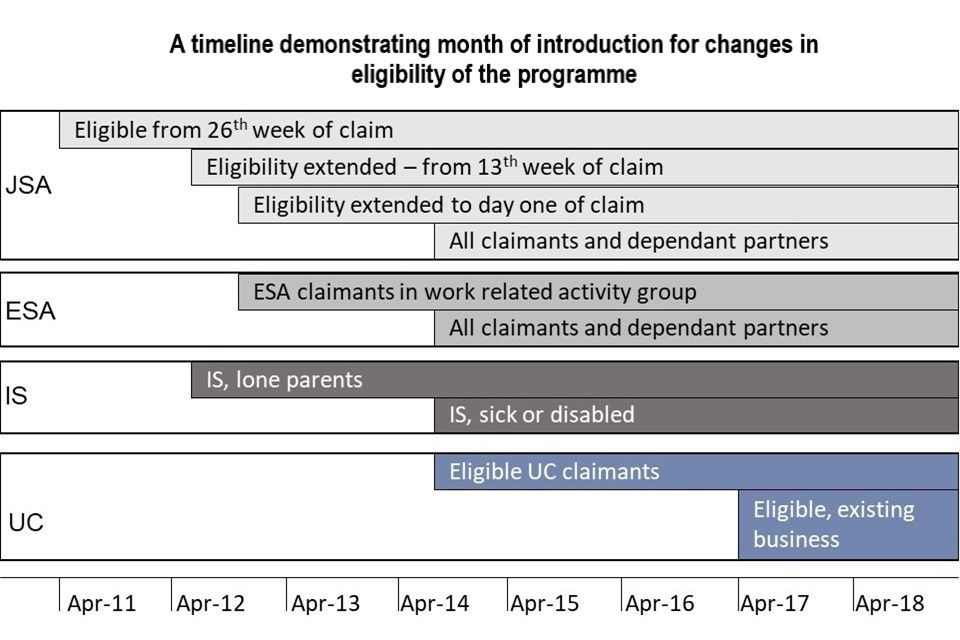
From January 2015 new starts to NEA have been delivered by contracted providers. The way data is collected for these Official Statistics has changed to reflect this; data for starts prior to January 2015 are taken from the Labour Market System and data for starts since January 2015 taken from the Provider Referral and Payment (PRaP) system.
For starts prior to January 2015 a start to NEA is defined as the date the claimant first met with their business mentor. For starts since January 2015, a start to NEA is defined as the date the provider accepted the claimant on the programme. These starts have previously been recorded in the Official Statistics as “mentor starts”.
For starts prior to January 2015, a business start is recorded when the claimant begins claiming the weekly allowance. For starts since January 2015, a business start is recorded when the claimant starts trading. This statistical release includes starts on both phase 1 and 2 of the programme.
4. All starts to New Enterprise Allowance
NEA and business starts peaked in 2013 and declined to a steady state of around 1,500 and 1,000 starts respectively until April 2020. Due to the impact of Covid-19, starts dropped in line with the introduction of restrictions in March 2020 before increasing to higher than pre-pandemic levels as restrictions eased in the summer.

- there have been 299,000 starts to NEA and 161,000 businesses set up through the programme since April 2011.
- in 2021, there were around 30,500 starts to NEA; this is a significant increase from 20,000 starts in 2020
The fall in starts to NEA and business starts in April 2017 was a result of an introduction of the Link Up: Start Up (LUSU) workshop process.
It is possible that people have participated more than once on NEA.
Since April 2011, a total of 276,000 individuals have started on the programme and up to June 2021, 157,000 individuals (57%), have progressed to set up a business.
The proportion of business starts over NEA starts had been steadily increasing since November 2014 to almost 65%, before seeing a significant drop to a low of 47% in March 2020 due to the impact of Covid-19 restrictions. From January 2021 to June 2021 the proportion fell from 58% to 46%.
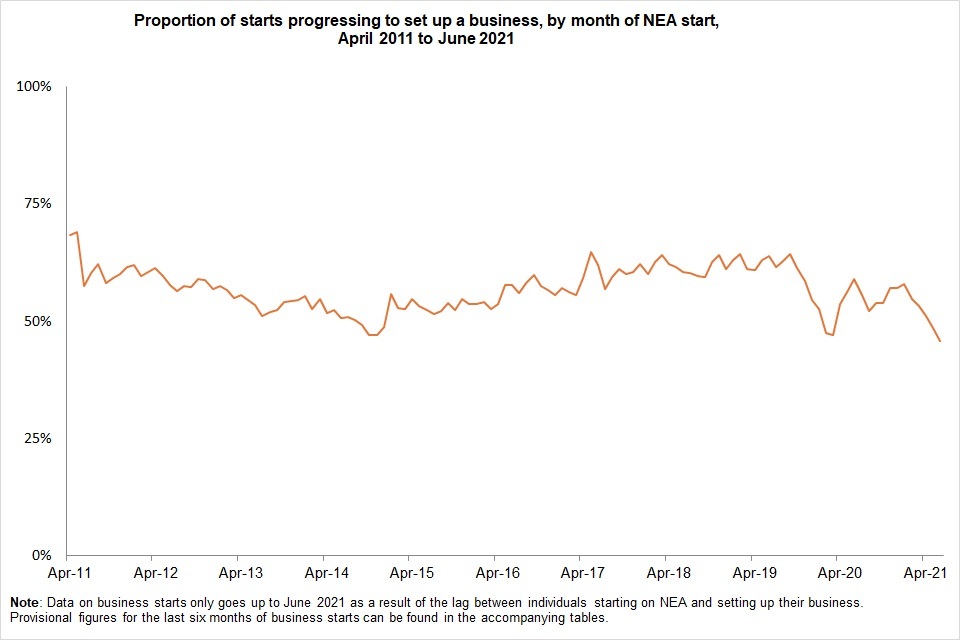
5. Main benefit of individuals starting New Enterprise Allowance
The main benefit of participants has gradually shifted from Jobseekers Allowance to Universal Credit over the years.
Of those starting on NEA in December 2021, around 92% were on UC, 6% were on JSA, less than 1% were on ESA or IB and less than 1% were on IS.
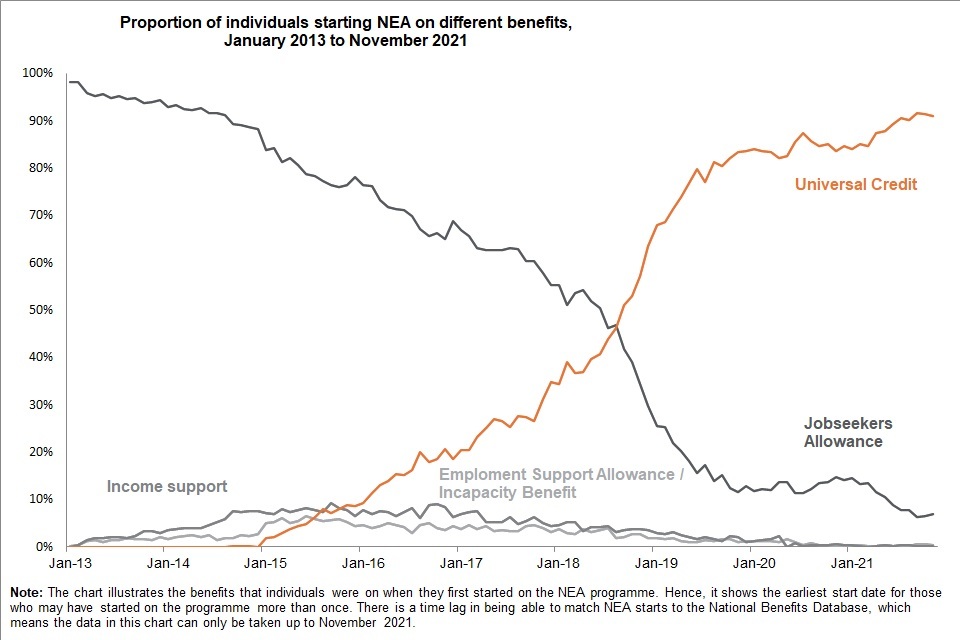
Initially, NEA was only available to JSA claimants. It has since been gradually rolled out to Employment Support Allowance/Incapacity Benefit, Income Support and Universal Credit claimants.
Universal Credit will eventually replace all non-contributory out of work benefits, including Jobseeker’s Allowance, Employment and Support Allowance and Income Support.
Now that all new income-related benefit claims are made to Universal Credit, the majority of people claimed UC before participating in New Enterprise Allowance. While some UC claimants are in-work, but require in-work financial aid, the NEA programme is only available to those UC claimants who are not in employment, education, or training.
Phase 2 of the programme was made available to a wider range of claimants, including UC recipients with existing businesses. NEA Starts for this group of claimants are reported separately within this publication.
6. Characteristics of those on New Enterprise Allowance
Out of the people who started on NEA, around 110,000 (42%) were women and 155,000 (59%) were men, of which around 65,000 and 86,000 respectively have progressed to set up a business respectively.
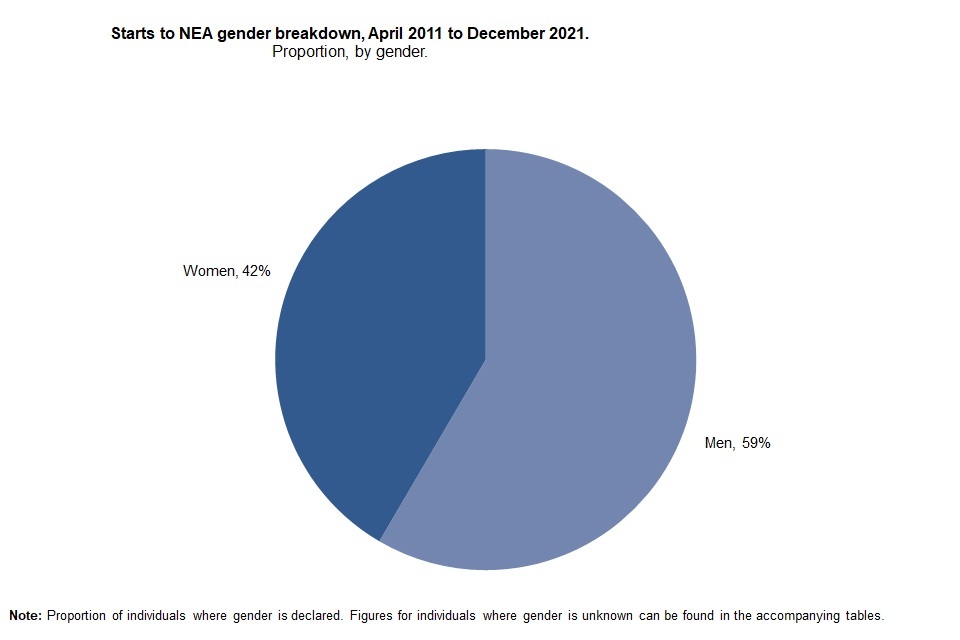
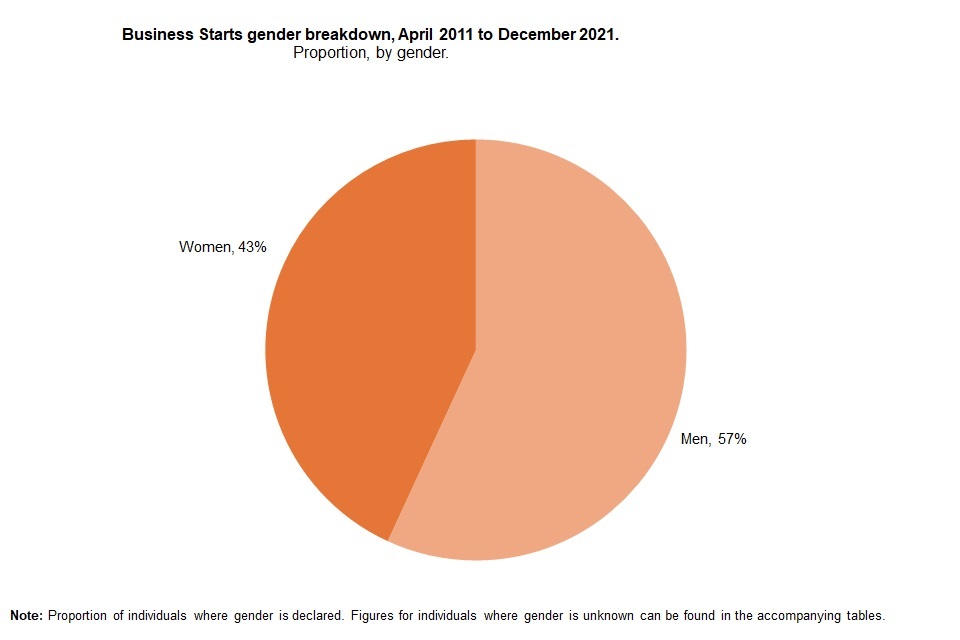
Around 43% of business starts following NEA were by women and 57% were by men.
The majority (70%) of starts to NEA are aged 25-49, with around 185,000 individuals starting NEA in this age group. As of December 2021, 106,000 businesses were started from this age group.
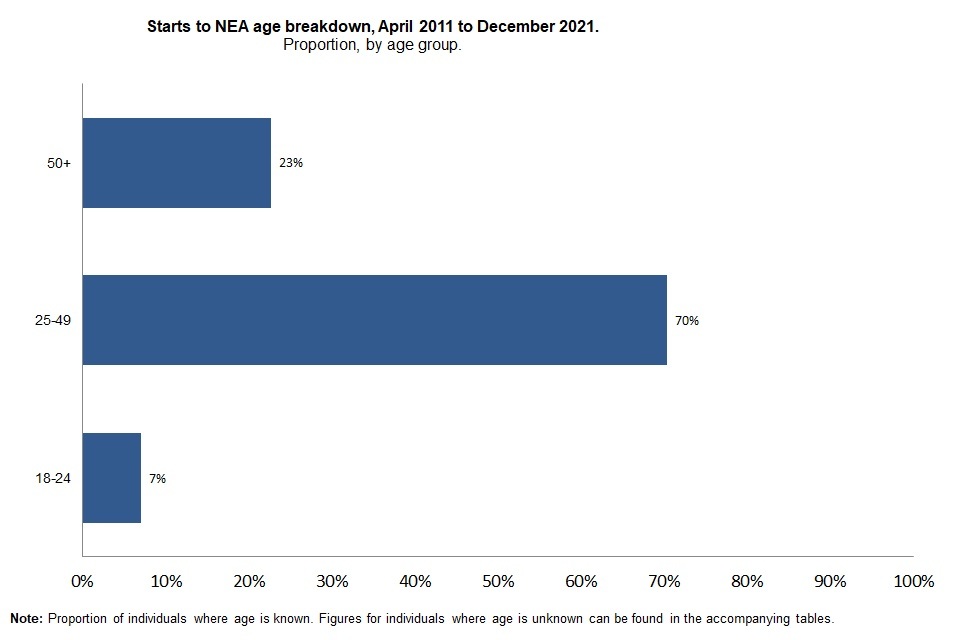

Of individuals whose ethnicity is known, around 205,000 (79%) of those who started the programme have identified as white, with a further 16% from ethnic minorities and 5% where ethnicity was not disclosed. As of December 2021, 121,000 businesses were started claimants identifying as ‘white’, 21,000 businesses were started by ethnic minorities, and 7,000 businesses were started where ethnicity was not disclosed.
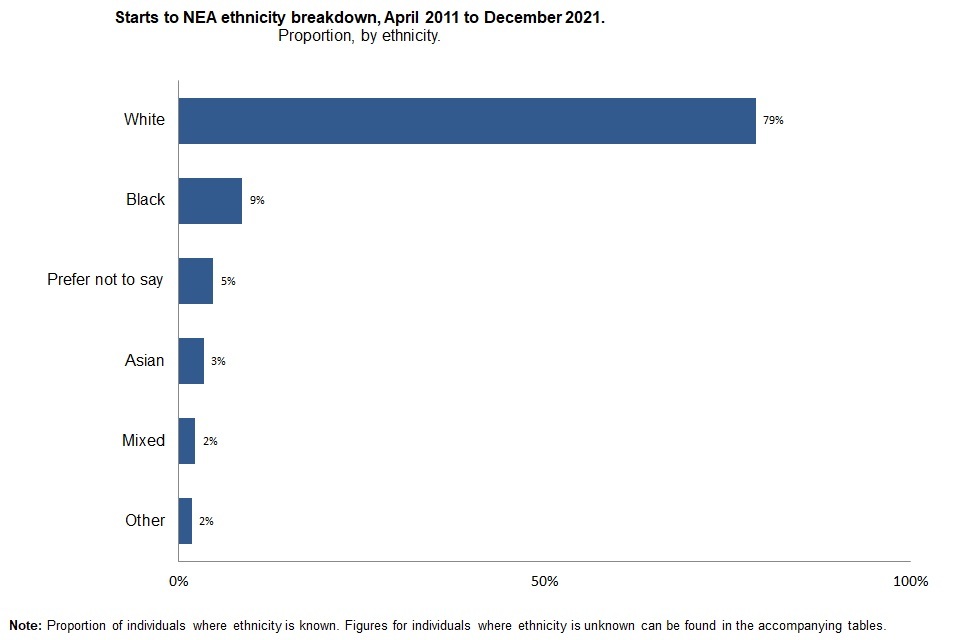

Of those starting on NEA, around 63,000 had a self-declared disability, with around 34,000 of these individuals progressing to set up a business.


7. Proportion of individuals off benefits continuously, for 26 weeks following the business start
When tracking participants for 26 weeks (6 months) after a business start, we looked at those who were off benefit continuously (all 26 weeks, without a break).
Overall, since the start of the programme, the average proportion of NEA participants who were off benefit for 26 weeks continuously following their business start was around 82%. This figure excludes Universal Credit claimants, who remain on Universal Credit after they start trading.
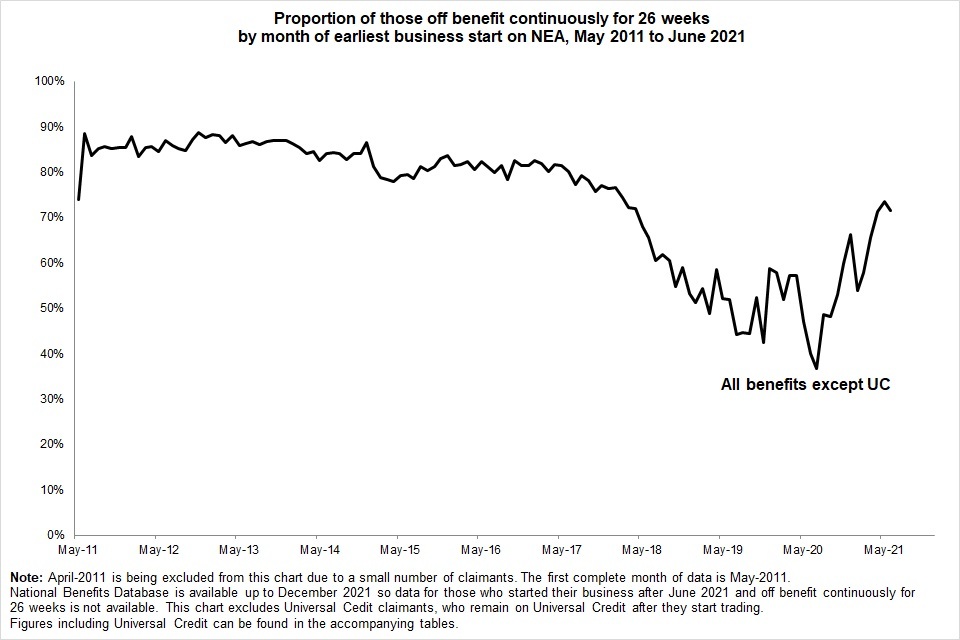
The decline from 2018 in the proportion of individuals on benefits other than Universal Credit, who remain off-benefit for 26 weeks following a business start is likely due to these claimants moving onto Universal Credit once they begin trading. The proportion fell further at the start of the COVID-19 pandemic to 37% in July 2020 and has since increased to 71% in June 2021.
Before the introduction of Universal Credit, claimants who had been on JSA were required to cease claiming DWP benefits to be entitled to payment of the trading allowance.
With the introduction of Universal Credit, low-earning self-employed people may be entitled to claim Universal Credit as an in-work benefit. Universal Credit claimants are excluded from the proportions shown here, but data including them can be found in the accompanying tables.
The smaller number of NEA starts coming from benefits other than Universal Credit accounts in recent years accounts for the greater monthly fluctuation in the proportion of these individuals off benefit.
8. New Enterprise Allowance: Contractual performance
The contractual performance data is for the NEA Phase 2 programme over the period January 2021 to December 2021. Figures for all contract packages areas are in the accompanying tables.
The programme is delivered by 7 providers operating in 14 contract package areas (CPAs). For each CPA there is an expected performance level of the numbers of business starts and also of the number reaching 26 weeks trading. The actual performance as a percentage of the expected performance is reported.
For business starts, actual performance as a proportion of expected performance ranges from 61% for Pinnacle People to 110% for Gateshead Trading Company.

For 26 weeks trading, actual performance as a proportion of expected performance ranges from 43% for Pinnacle People to 119% for Business Sense Associates.

9. NEA Phase 2: Starts from April 2017 to June 2020
Phase 2 of the programme, introduced in April 2017, involves claimants attending a Link Up: Start Up (LUSU) Workshop before moving on to start to NEA. Previously, starts on a LUSU Workshop and starts to NEA were recorded separately. From 6 July 2020, the LUSU start was no longer recorded and so the charts below only reflect the period April 2017 to June 2020. Figures for LUSU starts up to 6 July 2020 can be found in the accompanying tables.
Over the period, April 2017 to June 2020, 85,000 Link Up: Start Up (LUSU) starts were reported and lead to 55,000 NEA Starts.
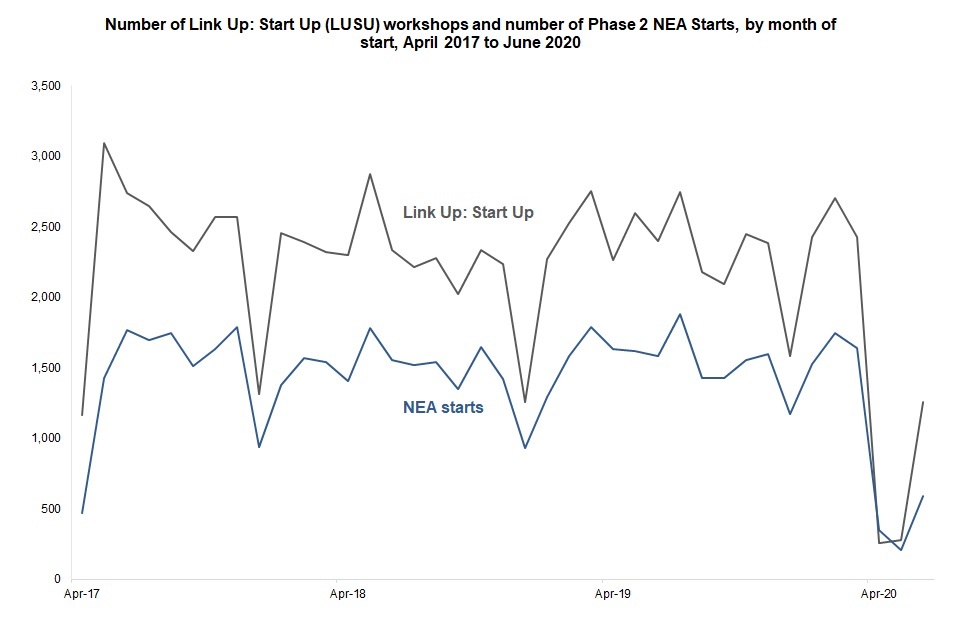
Over the period, April 2017 to June 2020, 65% of LUSU workshop attendances resulted in a start to NEA. This compares all starts to NEA, rather than tracking individuals.

10. NEA delivery
New Enterprise Allowance is delivered by private providers on behalf of the Secretary of State for Work and Pensions. Providers compete via competitive tender, and contracts are awarded regionally. DWP assesses these contracts to ensure value for public funds is met.
Role of the Provider
Jobcentre Plus informed eligible claimants about the NEA Mentoring Programme.
New Business Starts
For new business starts, the process was as follows:
- the JCP Adviser made a referral to the core NEA programme. The provider could then accept or reject the referral
- the participant would first take part in a LUSU workshop. Before the Covid-19 pandemic, these were delivered face-to-face but since then the Provider shares the LUSU information with the claimant prior to the initial assessment
- providers conduct an initial assessment within 15 working days to assess if the participant had a viable business plan with a reasonable chance of success
- providers then notified Jobcentre Plus via the PRaP system within 20 working days. The outcome of the initial assessment was also notified to the Jobcentre Plus Work Coach on a NEA1/UCNEA1 form within 2 working days of the initial assessment. This part of the provision is ESF match funded so there is ESF paperwork to complete
- the provider also completed an ESF1420 form with the participant as part of the assessment process and this had to be sent electronically to DWP within 10 working days of the participant signing it
Existing Self-Employed
For Universal Credit Existing Self-Employed:
- the JCP Adviser made a referral for an initial assessment, which the provider could then accept or reject
- providers conducted an initial assessment within 15 working days of referral date to assess if the participant would benefit from the support of the NEA Phase 2, where the business has potential to grow, become more efficient and more profitable
The aim is to improve the business earnings to reach a level up to or above their Minimum Income Floor (MIF) over the 12 month/52 week mentoring period.
The remaining process for new business starts and existing self-employed is as follows:
- providers assign a business mentor who assists the participant to develop a business plan (or a Business Development and Growth Plan, for UC FS existing self-employed participants). For the participant with actively seeking work in their conditionality, this is replaced with participants must make full commitment to the NEA mentoring programme
- participants then submit business plans for consideration
- if approved, participants proceed to trading (or for those existing self-employed participants, receive help to grow their business). At this stage, participants who are not claiming UC are no longer eligible for out of work benefits
- to support the participants, the business mentor continues to support the participant for the first 12 months
New business start participants may also be eligible for the NEA financial support which is administered by Jobcentre Plus. The allowance element of NEA is paid weekly at £65 for the first 13 weeks of trading followed by £33 for the remaining 13 weeks.
Providers must also ensure participants are informed of start-up loans provided by the Government-backed Start-Up Loans Company to access additional start-up capital (this is for new business cases only).
DWP made some interim arrangements to mitigate the impact of the COVID-19 restrictions on the delivery and performance of some employment programmes. Where applicable, contracts delivering NEA have been temporarily moved to a ‘cost’ payment model to allow for continued support for those customers most in need. Under this system the providers’ costs for delivering the contracted service were met, rather than paying a service fee and outcome-related payments.
11. About these statistics
These official statistics have been compiled using data from:
- Labour Market System (LMS) Opportunities Dataset
- Provider Referral and Payment System (PRaP), March 2022
- National Benefits Database, December 2021
- Universal Credit (UC) Official Statistics Dataset, April 2022
- Client Extract Data, March 2022
Status of the statistics
This document includes figures from April 2011 to December 2021 for the New Enterprise Allowance programme. Prior to 2015, data was taken from the Labour Market System (LMS). Since January 2015, data has been taken from the Provider Referrals and Payments (PRaP) dataset. The March 2022 PRaP dataset has been used, with data taken up to the end of December 2021. The December 2021 National Benefit Database and the April 2022 UC Official Statistics Dataset have also been used.
This is the final release in this series. It covers all starts to the NEA programme up to its closure to new participants from 1 January 2022, and the outcome after 26 weeks of all individuals starting up to June 2021. The data we will not report on consists of the outcome after 26 weeks of individuals starting between July 2021 and December 2021. All but 1,000 of those individuals had Universal Credit as their main benefit, and therefore would not be expected to leave benefits within 26 weeks.
Where to find out more
Statistician: Daniel Wilson, daniel.wilson4@dwp.gov.uk
Lead Statistician: Thomas Lloyd, thomas.lloyd2@dwp.gov.uk
Publication page for this document and the summary tables.
Older releases can be found in the in the collection of New Enterprise Allowance statistics.
A more detailed background note provides information on the New Enterprise Allowance programme and the statistics we published on it.
